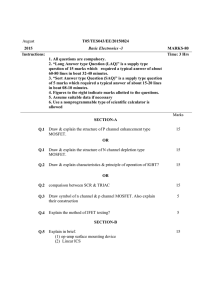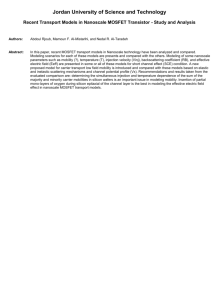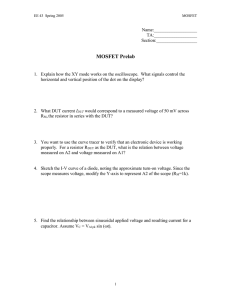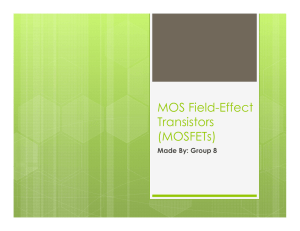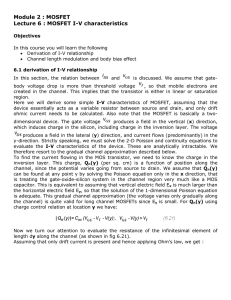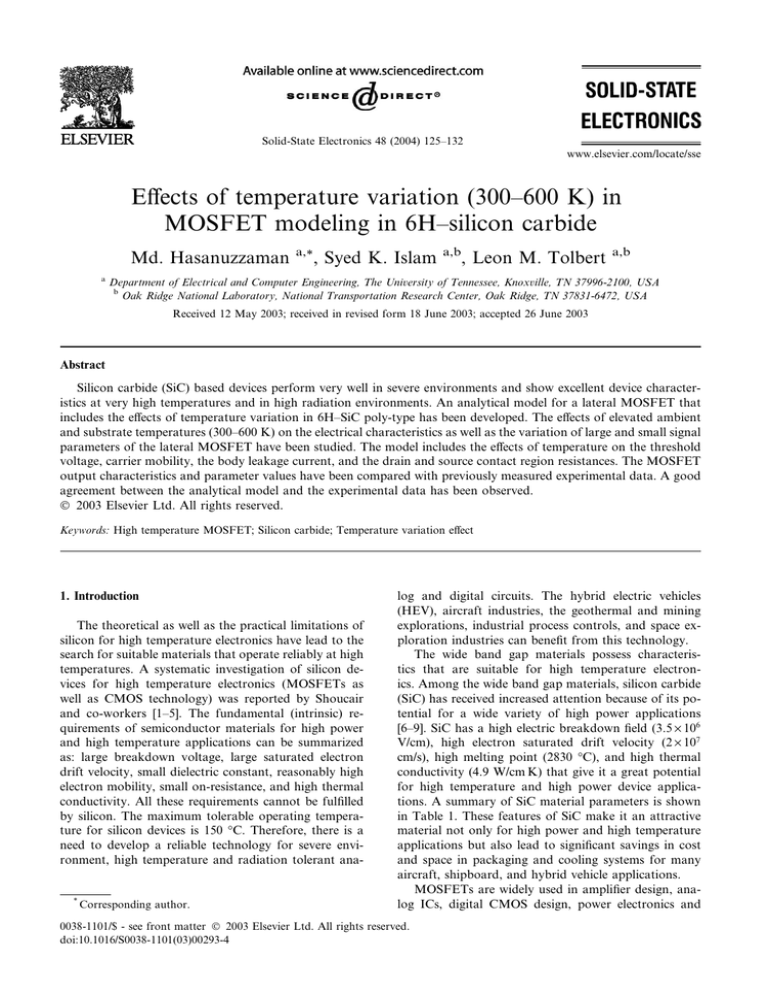
Solid-State Electronics 48 (2004) 125–132
www.elsevier.com/locate/sse
Effects of temperature variation (300–600 K) in
MOSFET modeling in 6H–silicon carbide
Md. Hasanuzzaman
a
a,*
, Syed K. Islam
a,b
, Leon M. Tolbert
a,b
Department of Electrical and Computer Engineering, The University of Tennessee, Knoxville, TN 37996-2100, USA
b
Oak Ridge National Laboratory, National Transportation Research Center, Oak Ridge, TN 37831-6472, USA
Received 12 May 2003; received in revised form 18 June 2003; accepted 26 June 2003
Abstract
Silicon carbide (SiC) based devices perform very well in severe environments and show excellent device characteristics at very high temperatures and in high radiation environments. An analytical model for a lateral MOSFET that
includes the effects of temperature variation in 6H–SiC poly-type has been developed. The effects of elevated ambient
and substrate temperatures (300–600 K) on the electrical characteristics as well as the variation of large and small signal
parameters of the lateral MOSFET have been studied. The model includes the effects of temperature on the threshold
voltage, carrier mobility, the body leakage current, and the drain and source contact region resistances. The MOSFET
output characteristics and parameter values have been compared with previously measured experimental data. A good
agreement between the analytical model and the experimental data has been observed.
2003 Elsevier Ltd. All rights reserved.
Keywords: High temperature MOSFET; Silicon carbide; Temperature variation effect
1. Introduction
The theoretical as well as the practical limitations of
silicon for high temperature electronics have lead to the
search for suitable materials that operate reliably at high
temperatures. A systematic investigation of silicon devices for high temperature electronics (MOSFETs as
well as CMOS technology) was reported by Shoucair
and co-workers [1–5]. The fundamental (intrinsic) requirements of semiconductor materials for high power
and high temperature applications can be summarized
as: large breakdown voltage, large saturated electron
drift velocity, small dielectric constant, reasonably high
electron mobility, small on-resistance, and high thermal
conductivity. All these requirements cannot be fulfilled
by silicon. The maximum tolerable operating temperature for silicon devices is 150 C. Therefore, there is a
need to develop a reliable technology for severe environment, high temperature and radiation tolerant ana-
*
Corresponding author.
log and digital circuits. The hybrid electric vehicles
(HEV), aircraft industries, the geothermal and mining
explorations, industrial process controls, and space exploration industries can benefit from this technology.
The wide band gap materials possess characteristics that are suitable for high temperature electronics. Among the wide band gap materials, silicon carbide
(SiC) has received increased attention because of its potential for a wide variety of high power applications
[6–9]. SiC has a high electric breakdown field (3.5 · 106
V/cm), high electron saturated drift velocity (2 · 107
cm/s), high melting point (2830 C), and high thermal
conductivity (4.9 W/cm K) that give it a great potential
for high temperature and high power device applications. A summary of SiC material parameters is shown
in Table 1. These features of SiC make it an attractive
material not only for high power and high temperature
applications but also lead to significant savings in cost
and space in packaging and cooling systems for many
aircraft, shipboard, and hybrid vehicle applications.
MOSFETs are widely used in amplifier design, analog ICs, digital CMOS design, power electronics and
0038-1101/$ - see front matter 2003 Elsevier Ltd. All rights reserved.
doi:10.1016/S0038-1101(03)00293-4
126
Md. Hasanuzzaman et al. / Solid-State Electronics 48 (2004) 125–132
Table 1
Comparison of Si and SiC material properties [9]
Properties
Si
6H–SiC
4H–SiC
Band gap (eV)
Dielectric constant
Breakdown field
(V/cm)
Saturated velocity
(cm/s)
Electron mobility
(in bulk) (cm2 /V s)
Hole mobility
(in bulk) (cm2 /V s)
Thermal conductivity
(W/cm K)
Melting point (C)
1.11
11.8
6 · 105
2.9
9.7
35 · 105
3.2
9.7
35 · 105
1 · 107
2 · 107
2 · 107
1350
380
800
450
95
120
1.5
4.9
4.9
1420
2830
2830
switching devices. Diodes and MOSFETs are used as
switching devices in dc–dc converters and ac drives that
are extensively used in power electronics, power systems,
traction drives, and HEV applications. A model for a
vertical MOSFET, which is a suitable structure for a
power MOSFET, has been developed and its impact on
the system level benefits of SiC MOSFET has been
studied and reported [10–12]. The performance of the Sibased switches is approaching the theoretical limits in
high power applications due to its intrinsic material
properties. SiC is an alternate material system that can
be used to overcome the limitations of the Si-based
switching devices and can be used in extreme environments.
The MOSFET device characteristics and circuit behavior that changes with the increase in temperature can
be predicted and simulated with a suitable model. Unfortunately, no reliable MOSFET device model has been
reported that includes the effects of change in temperature. Temperature dependency of model parameters of
6H–SiC MOSFET was explained from measured data
[13]. Some empirical relations for MOSFET parameters
i.e. threshold voltage, mobility etc. have also been extracted from experimental data [13]. A CMOS process
has been developed, fabricated and tested in 6H–SiC
[14]. The measured data for NMOS and PMOS output
characteristics, transfer characteristics, threshold voltage, and sheet resistances were reported in [14]. This
paper presents an analytical model for lateral MOSFET
in 6H–SiC that includes the effects of temperature. The
aim of this model is to establish a relationship between
the MOSFET’s output characteristics and temperature
while explaining the factors affecting it at high temperature. The model includes the effects of temperature on
the threshold voltage, carrier mobility, the body leakage
current, and the drain and source contact region resistances. Output characteristics and temperature dependent parameters have been evaluated using the proposed
model with the device dimensions described in [14].
Preliminary results from the analytical model and measured data presented in [14] demonstrate the feasibility
of the developed model.
2. Proposed model
A detailed and intensive study has been made on
different MOSFET device parameters and device behaviors, and the temperature dependent terms were
determined from the study. Changes in material properties with temperature as well as the contribution to
the output current due to the physical structure of
MOSFET have been taken into consideration. A largesignal model for a lateral MOSFET with temperature
compensation has been proposed (Fig. 1). The temperature dependent compensating current elements are
considered to be in parallel with the MOSFET channel between the drain and the source. These currents
contribute to the total current at high temperature. The
three compensating current elements are (i) the body
leakage current, IR ; (ii) current change due to the
threshold voltage change, ITH ; (iii) current change due
to the change of drain and source contact region
resistance, IRDS . Room temperature (300 K) has been
taken as the reference temperature. MOSFET channel current, ID has been calculated at room temperature using Eqs. (1) and (2) which are obtained from
MOSFET charge sheet model [15]. Channel current,
ID is kept constant for all temperature. The compensating currents incorporate the change in MOSFETs
current.
ID ¼
W
l Cox ½ðVGS VTH Þ VDS =2VDS ;
L n
ID sat ¼
W
l Cox ðVGS VTH Þ2 ;
2L n
ð1Þ
ð2Þ
D
Itotal
ID
G
IR
ITH
IRDS
S
Fig. 1. MOSFET model with temperature compensation.
Md. Hasanuzzaman et al. / Solid-State Electronics 48 (2004) 125–132
127
Table 2
List of abbreviations used in equations
Drain current in linear region operation
Drain current in saturation region operation
Body leakage current
Current due to threshold voltage change
Current due to drain and source contact resistance change
Gate to source voltage
Drain to source voltage
Threshold voltage at room temperature
Threshold voltage at elevated temperature
Flat band voltage
Constant
Drain and source contact resistance at room temperature
Drain and source contact resistance at elevated temperature
MOSFET channel width
MOSFET channel length
Doping concentration of the acceptor atoms
Electron mobility
Oxide capacitance
Proportionality constant
Multiplying factor
Intrinsic carrier concentration
Density of states in the conduction band
Density of states in the valance band
Band gap
Fermi energy level
Intrinsic energy level
Surface potential
Band bending on metal side
Band bending on semiconductor side
Difference between metal and semiconductor band bending
Boltzmann constant
Temperature
Interface state density
Work function for SiC
Diffusion coefficient
Diffusion length
Electron charge
Cross-sectional area of pn junction
Doping density
Fixed oxide charge
Charge trapped in interface states
ID
ID sat
IR
ITH
IRDS
VGS
VDS
VTH
VTH0
Vfbo
V0
RDS
RDS0
W
L
NA
ln
Cox
a
b
ni
Nc
Nv
Eg
Ef
Ei
Uf
Um
Us
Ums
k
T
DQit
vSiC
Dn
Ln
q
A
N
Qf
Qit
where symbols have their usual meaning. Eq. (1) is used
in the linear region operation and Eq. (2) is used in the
saturation region operation of the MOSFET. A list of
symbol abbreviations is shown in Table 2.
The total drain current can be expressed by Eq. (3)
as
Itotal ¼ ID þ IR þ ITH þ IRDS ;
ð3Þ
where
IR ¼ qA
ITH ¼
Dn n2i
Eg
;
aAT 3 exp Ln NA
kT
W
0
l Cox ½VTH
VTH VDS ;
L n
ð4Þ
ð5Þ
ITHsat ¼
h
i
W
0
ln Cox ðVGS VTH
Þ2 ðVGS VTH Þ2 ;
2L
IRDS ¼ b
1
1
VDS :
0
RDS RDS
ð6Þ
ð7Þ
The change in current due to the change in threshold
voltage is evaluated by Eq. (5) for linear region operation and by Eq. (6) for saturation region operation. At
room temperature, IR is negligible; ITH and IRDS become
zero. However, with the increase in temperature, compensating terms contribute to the total current. The
major factors of the compensating currents are discussed
in the following sections.
128
Md. Hasanuzzaman et al. / Solid-State Electronics 48 (2004) 125–132
2.1. Leakage currents
2.2. Threshold voltage
Body leakage current is proportional to intrinsic
carrier concentration, ni . At room temperature, ni of SiC
is very low. Thus, the contribution of the leakage current
is negligible. However, with the increase in temperature,
ni increases exponentially. Therefore, leakage current
contributes to the total current at high temperature. Let
us consider the large-signal model of the lateral MOSFET as shown in Fig. 2 with the effect of leakage currents. The drain to body leakage current is invariably
found to be due to the diffusion across the reverse biased
pn junction under consideration. For an n-channel
MOSFET device, the temperature dependence of the
leakage current can be expressed by Eq. (4), which is
basically the reverse saturation current of a diode [3].
The term 1=T inside the exponent bracket is the dominant temperature factor compared to the T 3 outside the
bracket. Here, q is the electron charge, A is the area of
the pn junction, and a is the proportionality factor. The
existence of the leakage current can be shown in the
large-signal MOSFET model by placing a diode between
the drain and the body terminal. The electrical largesignal model is thus equivalent to adding a temperature
dependent current source between the drain and the
source terminals.
Threshold voltage is the most significant parameter
in the study of temperature dependence of MOSFET
characteristics. MOSFET current–voltage characteristics are proportional to the square of the difference of
gate voltage and threshold voltage. Thus, a small change
in threshold voltage causes a large change in the output
current. Therefore, it is very important to calculate the
threshold voltage accurately with temperature changes.
There are many material parameters that are related to
the calculation of threshold voltage, and a number of
empirical relationships have been obtained from experimental data [16]. Let us consider the simple band diagram of metal oxide semiconductor as shown in Fig. 3.
Threshold voltage of MOSFET can be calculated using
Eq. (8):
VTH ¼ Vfbo pffiffiffiffiffiffiffiffiffiffiffiffiffiffiffiffiffiffiffiffiffi
DQit
2Uf 2V0 ð2jUf jÞ;
Cox
ð8Þ
where Uf is the surface potential, which is given by Eq.
(9):
kT
n
ln
Uf ¼
:
ð9Þ
q
ni
The variation of the intrinsic carrier concentration ni
with temperature is given by Eq. (10):
Eg
:
ð10Þ
ni ¼ ðNc Nv Þ1=2 exp 2kT
G
S
D
n+
The density of states in the conduction band, Nc , the
valence band, Nv and the bang gap energy, Eg can be
obtained by Eqs. (11)–(13), respectively:
n+
Channel
p- substrate
Nc ffi 1:73 1016 T 3=2 ;
ð11Þ
Nv ffi 4:8 1015 T 3=2 ;
ð12Þ
Vacuum level
(a)
D
χ1
D
χ2
(1)
(2)
Ec
Ec
Ef
Reverse
Bias Diode
G
G
IR
Ev
S
(b)
Φf
S
Ef
(c)
Fig. 2. Large signal model of n-channel MOSFET including
the effect of leakage currents: (a) physical structure, (b) equivalent transistor, (c) electrical model.
Ev
Polysilicon
Oxide
Silicon Carbide
Fig. 3. Band diagram of metal–oxide semiconductor.
Md. Hasanuzzaman et al. / Solid-State Electronics 48 (2004) 125–132
Eg ffi Eg ð0Þ 6:5 104 T2
:
T þ 200
129
ð13Þ
The flat band voltage also changes with temperature and
can be calculated by Eq. (14), where Ums ¼ ð1Þ ð2Þ
(Fig. 3) is the difference between metal and semiconductor band bending:
Qf
Qit ðUs ¼ 0Þ
Vfbo ¼ Ums Cox
Cox
Eg
Qf þ Qit ðUs ¼ 0Þ
¼ Um vSiC þ þ ðEf Ei Þ :
Cox
2
ð14Þ
The interface state density, DQit and V0 (Eq. (16)) are the
only temperature independent parameters, which can be
calculated by Eqs. (15) and (16), respectively:
DQit ¼ Qit ð2Uf Þ Qit ð0Þ;
ð15Þ
Fig. 4. Variation of sheet resistance with temperature.
qeSiC N
:
V0 ¼
2
Cox
ð16Þ
A high interface state density for SiO2 /SiC interface has
been reported in [17]. The reasons for high interface
state density are discussed in Section 3.
2.3. Mobility
Electrons and holes mobilities in a doped semiconductor decrease due to the increase of phonon effects
with the temperature. A model for electron mobility of
SiC material is shown in [18]. The model includes only
the bulk mobility. However, the inversion layer mobility
of SiC is much smaller than the bulk mobility. High
interface state density plays an important role in inversion layer mobility. Experimentally measured mobility
values in the inversion layer have been reported in
[13,14]. The reported mobility values show an interesting
trend in mobility. Initially, the mobility increases (which
is opposite to the expected nature of mobility) for a
working temperature range of 300–500 K. This may be
due to the early movement of Fermi level towards the
band gap with increased temperature. However, the
mobility decreases at very high temperature where lattice
scattering dominates and begins to release the interface
trap charges. Therefore, the inversion layer mobility is
almost constant over the temperature range (300–600 K)
considered in the model. A constant value of mobility
(21 cm2 /V s) has been used in the simulations.
2.4. Contact region resistances
The drain and the source metal contact resistances
and nþ region sheet resistance of the MOSFET also
change with temperature. It is shown in [14] that the
value of sheet resistance at 600 K becomes almost half of
the value at 300 K. Therefore, less voltage drop occurs at
the drain and source contacts, and the channel has more
drain to source voltage, which ultimately causes the
drain current to increase. Fig. 4 shows the measured
sheet resistance of the nþ contact regions of the 6H–SiC
lateral MOSFET. The resistance values decrease almost
linearly. Therefore, a linear approximation has been
made in the calculation of the resistances. The change of
resistance can be calculated by Eq. (17):
4
R0DS ¼ 920 ðT 300Þ:
3
ð17Þ
The resistance of the metallic contact is negligible due to
larger contact area. Therefore, only the change of the
sheet resistance has been considered into the resistance
calculation. The change in the drain and source resistances has been modeled as a change in conductance,
and the effective increase in current, IRDS is expressed by
Eq. (7) where b is a fitting parameter to match the total
current, RDS is the total drain and source contact region
resistance at room temperature and R0DS is the total drain
and source contact region resistance at elevated temperature.
3. Results and discussion
The aim of the present work is to develop an analytical model to explain and interpret the change of output
characteristics with temperature for the measured data
shown in [14]. The model has been evaluated in 6H–SiC
material system and the same device dimensions as
those of [14] are used for simulations. The output characteristics have been simulated at 300, 400, 500 and 600
K. Figs. 5 and 7 show the output characteristics for
130
Md. Hasanuzzaman et al. / Solid-State Electronics 48 (2004) 125–132
Fig. 5. Output characteristics for simulated and measured data
at 300 K.
Fig. 7. Output characteristics for simulated and measured data
at 600 K.
Fig. 6. Transfer characteristics simulated at drain–source
voltage VDS ¼ 5 V, temperature 300 K.
Fig. 8. Transfer characteristics simulated at drain–source
voltage VDS ¼ 5 V, temperature 600 K.
simulated and measured data at 300 and 600 K, respectively. The simulation results match perfectly with the
measured data at 300 K as compared to the results at
600 K where there are minor discrepancies. At 300 K, the
drain current is 15 lA whereas it rises to 235 lA at
600 K for a gate voltage VGS ¼ 6 V. At room temperature, the current starts conducting through the channel
at high gate voltage, VGS ¼ 3:2 V, whereas it starts
at VGS ¼ 1:2 V at 600 K. The transfer characteristics
are also simulated at a drain–source voltage VDS ¼ 5 V
and are shown in Figs 6 and 8 at 300 and 600 K, respectively.
The changes in threshold voltage with temperature
are also simulated and compared with measured data as
shown in Fig. 9. The SiC lateral MOSFET has a very
high threshold voltage i.e. 3.2 V at room temperature
and 1.2 V at 600 K [14]. The large variation of the
threshold voltage causes a huge change in the drain
currents of the MOSFET. There are very good agreements between the results of simulated and measured
threshold voltages. The contributions of the compensating currents to the total current change are evaluated
at different temperatures. Table 3 shows the relative
percentage of the current of the compensating terms. It
Md. Hasanuzzaman et al. / Solid-State Electronics 48 (2004) 125–132
131
4. Conclusions
An analytical model has been developed to explain
the behavior of the MOSFET output characteristics at
different temperatures. The model has been evaluated for
6H–SiC material system. It includes the change in the
threshold voltages, carrier mobility, the body leakage
current, and the drain and source contact resistances.
The MOSFET output characteristics and parameter
values are compared with previously measured experimental data. There is a good agreement between the
model outputs and the experimental data. The model can
be used to predict the MOSFET characteristics with
change of temperature.
Acknowledgements
Fig. 9. Threshold voltages obtained from simulation and
measurement for different temperature.
Table 3
Contribution of the compensating currents to the total current
change
Temperature (K)
Total
current
change
(lA)
% of
current
change due
to threshold voltage
% of
current
change
due to
body
leakage
% of
current
change due
to drain
source
resistance
400
500
600
45
116
220
90
85
78
2
6
15
8
9
7
has been observed that most of the current change
(about 85% on an average) is obtained by threshold
voltage change i.e. threshold voltage mostly characterizes the device behavior. At lower temperature, contribution of the leakage current is negligible. However, at
high temperature it plays a major role. Drain and source
resistances change monotonously with temperature.
The high interface state density results in a high
threshold voltage. The reasons for such high interface
state density is expected due to the damage caused by
ion implantation and high concentration of Boron atoms at the SiO2 /SiC interface. Due to low electrical activation rate, higher implantation doses are required to
obtain the desired acceptor concentrations for p-well,
which consequently degrades the SiO2 /SiC interface.
Low activation rate for Boron implants is also the reasons for relatively low value of effective channel mobility. A large surface density and high concentration of
Boron atoms at the SiO2 /SiC interface introduce more
scattering of the electron in the inversion layer, lowering
the effective channel mobility.
This work has been funded by the US Department of
Energy (DOE) and Oak Ridge National Laboratory
(ORNL) under a Laboratory Directed Research and
Development (LDRD) project.
References
[1] Shoucair FS, Early JM. High temperature diffusion leakage
current-dependent MOSFET small-signal conductance.
IEEE Trans Electron Devices 1984;31(12):1866–72.
[2] Shoucair FS. High temperature latchup characteristics in
VLSI CMOS circuits. IEEE Trans Electron Devices 1988;
35(12):2424–6.
[3] Shoucair FS. Electrical characteristics of large-scale integration silicon MOSFET’s at very high temperatures, Part
III: modeling and circuit behavior. IEEE Trans Compon,
Hybrid Manufact Technol, CHMT 1984;7(1):146–53.
[4] Shoucair FS. Design considerations in high temperature
analog CMOS integrated circuits. IEEE Trans Compon,
Hybrid Manufact Technol, CHMT 1986;9(3):242–51.
[5] Shoucair FS. CMOS logic cell switching speed thermal
characterization. Electron Lett 1987;23:458–60.
[6] Bhatnagar M, Baliga BJ. Comparison of 6H–SiC, 3C–SiC,
and Si for power devices. IEEE Trans Electron Devices
1993;40(3):645–55.
[7] Shenai K, Scott RS, Baliga BJ. Optimum semiconductors
for high power electronics. IEEE Trans Electron Devices
1989;36(9):1811–23.
[8] Morkoc H, Strite S, Gao GB, Lin ME, Sverdlov B, Burns
M. Large-band-gap SiC, III–V nitride, and II–V ZnSebased semiconductor device technologies. J Appl Phys
1994;76(3):1363–97.
[9] Weitzel C, Palmour J, Carter C, Moore K, Nordquist K,
Allen S, et al. Silicon carbide high-power devices. IEEE
Trans Electron Devices 1996;43(10):1732–41.
[10] Hasanuzzaman M, Islam SK, Tolbert L, Ozpineci B.
Model simulation and verification of a vertical double
implanted (DIMOS) transistor in 4H–SiC. In: Proceedings
of the 7th IASTED International Multi-Conference. Palm
Spring; 2003. p. 313–6.
132
Md. Hasanuzzaman et al. / Solid-State Electronics 48 (2004) 125–132
[11] Ozpineci B, Tolbert L, Islam SK, Hasanuzzaman M. Effect
of silicon carbide (SiC) power devices on HEV PWM
inverter loss. In: 27th Annual Conference of the IEEE
Industrial Electronics Society; 2001. p. 1061–66.
[12] Ozpineci B, Tolbert L, Islam SK, Hasanuzzaman M.
System impact of silicon carbide devices. Int J High Speed
Electron Syst 2002;12(2):439–48.
[13] Rebello NS, Shoucair FS, Palmour JW. 6H silicon carbide
MOSFET modeling for high temperature analogue integrated circuits (25–500 C). IEE Proc-Circuits Devices Syst
1996;143(2):115–22.
[14] Ryu S-H. Development of CMOS Technology for Smart
Power Applications in Silicon Carbide. PhD thesis, Purdue
University, May 1997.
[15] Casey HC. Devices for integrated circuits, silicon and III–V
compound semiconductors. New York: John Wiley &
Sons; 1999.
[16] Levinshtein ME, Rumuantsev SL, Shur MS. Properties of
advanced semiconductor materials. The UK: John Wiley &
Sons; 2001.
[17] Shenoy JN, Chindalore GL, Melloch MR, Cooper JA,
Palmour JW, Irvine KG. Characterization and optimization of the SiO2 /SiC metal–oxide semiconductor interface.
J Electron Mater 1995;24(4):303–9.
[18] Roschke M, Schwierz F. Electron mobility models for 4H,
6H, and 3C–SiC. IEEE Trans Electron Devices 2001;48(7):
1442–7.

